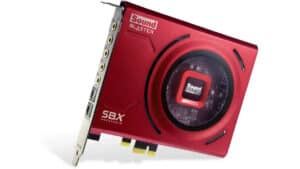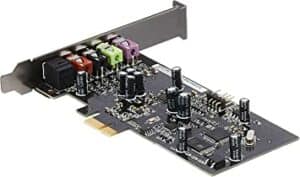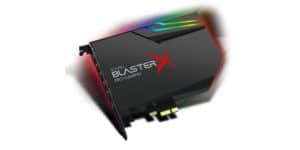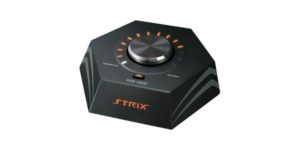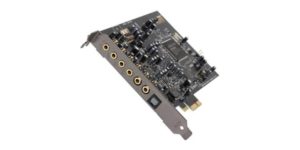Best Sound Cards In 2023
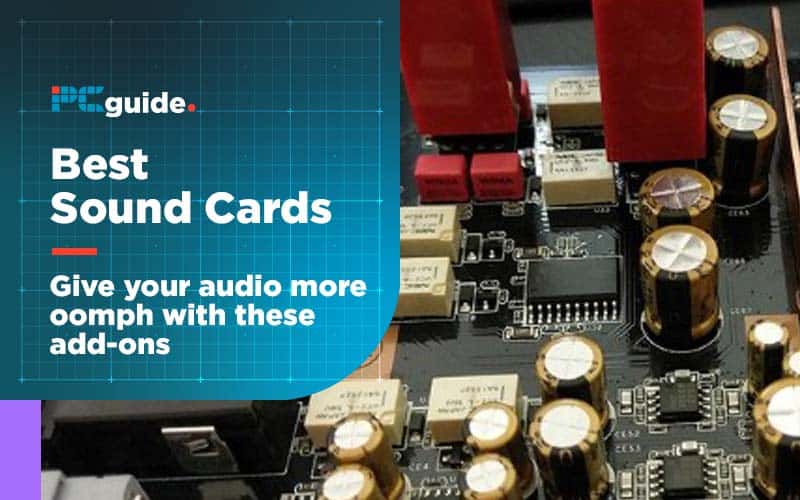
Table of Contents
The integrated audio output of newer computer motherboards has improved a lot over the years. So much so, in fact, that for the average gamer, you wouldn’t really need an audio card.
However, if you are an audiophile, dedicated esports gamer, or just looking to make your own media center, then there is definitely some value to be had here. A dedicated sound card provides far more sound clarity along with other features like headphone amplification, noise-free recording, and, most of all, high-end lossless audio quality.
Buying a sound card is a difficult thing to do for a lot of reasons. One, there are many industry standards and so many specifications. Two, most PC gamers are not overly familiar with audio-related terminology. Therefore, we have put together this guide for newcomers to the audio industry so that you can experience the best of the best.
Products at a Glance
Product Reviews
- Offers Virtual 7.1 surround sound
- Sound Blaster Command sotware
- Not for audiophiles
The Creative Sound Blaster Z SE sits at the top of our best Sound Cards list as a mix of of the right features. To start, it’s not too pricey, coming in at around $100 (or if you’re lucky, just under), and that’s a sweet spot for functional tech with added extras.
The Z SE’s main function is to enhance audio for productivity and gaming use of course – well above what a motherboard’s onboard chip can offer. And it’s certainly a good solution for doing so. Providing a 116dB signal-to-noise ratio at 192kHz for high-quality (indeed, high fidelity) output, the Z SE offers discrete 5.1 and virtual 7.1 support. This means it will offer 7.1 virtual surround sound via headphones and speakers, but won’t support actual 7.1 systems.
However, the Z SE does offer support for up to 600-ohm impedance headphones – none too shabby if you have ‘phones of that level available. In terms of extra features, this card supports Sound Blaster Command software, plus for gamers, there are SBX Gaming EQ profiles for titles including Apex Legends, Fortnite, Overwatch and PUBG.
This card has been around for a few years now, but the latest drivers do offer Windows 10 and Windows 11 support. So, if you have around $100 to spend and don’t require discrete 7.1 we don’t think you can go far wrong.
- Great price
- Most ideal for smaller cases
- No ASIO support
While Creative Sound might be one of the most well-known brands in sound cards, ASUS’s Xonar SE Gaming option is a sure-fire hit among the best sound cards in 2023. As the name implies, this card is geared specifically toward gamers, allowing users a Signal-to-Noise ratio of 116dB and high-resolution audio playback (5.1 channel) of up to 24-bit/192kHz.
At all but a mere $40, ASUS’ sound card is a powerful inclusion that leverages a ‘Hyper Grounding” technology that, according to the firm, limits distortion with the card. This helps aid the card in signal strength and sound quality, making any form of entertainment appealing no matter the environment.
The Xonar SE also comes equipped with four 3.5mm audio ports, a TOSLINK S/PDIF port, and a front audio header. With its compact size, the Xonar SE is quite easy to fit in smaller cases, making it ideal for those with less real estate in their chassis.
- High-resolution playback
- Aurora RGB lighting
- Molex power connector required for RGB
The Creative Sound BlasterX AE-5 is Creative’s latest addition to the gaming-oriented sound cards and it’s packed with features. First and foremost, while this is insignificant in the grand scheme of things, this is a nice looking card. This is largely due to its Aurora Reactive Lighting System, which makes this the first sound card with a built-in RGB controller.
The RGB does require a Molex power connector to power, which is an unfortunate requirement that you need to be aware of before investing in it. The sound card itself functions just fine without the additional power, though.
Like the Creative Sound Blaster ZxR, this sound card also does not feature 7.1-channel support, which is still disappointing, but not nearly as much so since it is significantly cheaper.
The sound card features one of the latest Sabre DACs with 32-bit 384-kHz playback and an SNR of 122 dB. Moreover, Sound Blaster has created a new methodology for headphone amplification. Called XAMP, the amplification is done on both headphone channels, supporting headphones with impedance-range of 16-600 Ohms. The most notable feature of the sound card is the inclusion of Scout 2.0, which greatly aids the user during competitive gaming.
We believe that this computer sound card is a must buy for people who want to experience the best in terms of competitive gaming, as its software features make it the best sound card for gaming, although it does not support true 7.1-channel surround sound.
- Offers 7.1-channel surround sound at a cheap price
- The volume control box provides ease of use
- Lower SNR than that of similarly priced cards
ASUS Strix RAID PRO is from the Strix lineup of sound cards, which are made for gamers, unlike the Essence series (seen with our first pick). Strix RAID PRO features two main components: the sound card and the additional volume control box.
The sound card provides a total of seven 3.5mm jacks, with support for 7.1-channel devices, box-link, mic-in, line-in, and S/PDIF-out.
The sound card requires additional power apart from PCIe power, which it receives through the 6-pin power connector.
The sound card features ESS Sabre9006A DAC, which supports up to 24bit 192-kHz playback with an SNR of 116 dB, which could have been a bit higher like the similarly priced BlasterX AE-5.
The sound also incorporates a dedicated headphone amp, supporting headphones with an impedance-range of 16-600 Ohms.
Customization options aplenty
The Strix Sonic Studio software provides many options to customize the audio such as Compressor, Perfect Voice, Noise Gate, and Voice Clarity. The sound card also supports the virtual 7.1 surround sound, with great control over the channel positions.
Overall, this gaming sound card rivals the features of the Creative Sound BlasterX AE-5.
While the AE-5 arguably offers better sound clarity, this supports 7.1 Surround Sound and has its snazzy volume control box.
- Cheap price for the features
- Buggy drivers
- Only three outputs for 7.1-channel devices
Here we are with another Creative product: the Creative Sound Blaster Audigy RX 7.1. This sound card is much cheaper than the previously mentioned sound cards, but this is at least partially due to the fact that it’s an old product.
Blured Lines
However, if you’re thinking that means it’s worse you’d be wrong as it provides sound quality that’s good enough to diminish the lines between a high-end and low-end sound card.
It features six 3.5mm jacks and one Toslink optical S/PDIF-out. The card features 7.1 channel support but provides only three output ports, which is why you might have a hard time connecting 7.1 channel devices.
The DAC of the Creative Sound Blaster Audigy sound card features 24-bit 192-kHz playback, while having an SNR of 106 dB, which is quite lower than other sound cards.
The sound card features the famous CMSS-3D positioning audio algorithm; however, I think the CMSS-3D is more a gimmick than an actually beneficial feature, so take from that what you will.
To conclude, this audio card might not be the best sound card out there but at this price point, you won’t find anything better.
Things to Consider
Our Verdict
A good mix of features, specs, and pricing – plus up-to-date software for compatibility up to Windows 11 – make this our pick of the best sound cards on the market right now. It may not be right for audiophiles, but it’ll be right for the large majority who want something far better than onboard sound chips can offer!

